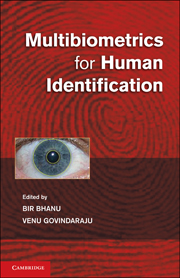Book contents
- Frontmatter
- Contents
- List of Contributors
- Preface
- Introduction
- PART I MULTIMODAL AND MULTISENSOR BIOMETRIC SYSTEMS
- PART II FUSION METHODS IN MULTIBIOMETRIC SYSTEMS
- PART III HYBRID BIOMETRIC SYSTEMS
- 8 Multiple Projector Camera System for Three-Dimensional Gait Recognition
- 9 Gait Recognition Using Motion Physics in a Neuromorphic Computing Framework
- 10 Face Tracking and Recognition in a Camera Network
- 11 Bidirectional Relighting for 3D-Aided 2D Face Recognition
- PART IV DATABASES AND SECURITY
- PART V PERFORMANCE OF MULTIBIOMETRIC SYSTEMS
- Plate section
9 - Gait Recognition Using Motion Physics in a Neuromorphic Computing Framework
from PART III - HYBRID BIOMETRIC SYSTEMS
Published online by Cambridge University Press: 25 October 2011
- Frontmatter
- Contents
- List of Contributors
- Preface
- Introduction
- PART I MULTIMODAL AND MULTISENSOR BIOMETRIC SYSTEMS
- PART II FUSION METHODS IN MULTIBIOMETRIC SYSTEMS
- PART III HYBRID BIOMETRIC SYSTEMS
- 8 Multiple Projector Camera System for Three-Dimensional Gait Recognition
- 9 Gait Recognition Using Motion Physics in a Neuromorphic Computing Framework
- 10 Face Tracking and Recognition in a Camera Network
- 11 Bidirectional Relighting for 3D-Aided 2D Face Recognition
- PART IV DATABASES AND SECURITY
- PART V PERFORMANCE OF MULTIBIOMETRIC SYSTEMS
- Plate section
Summary
Introduction
Interpreting how people walk is intuitive for humans. From birth, we observe physical motion in the world around us and create perceptual models to make sense of it. Neurobiologically, we invent a framework within which we understand and interpret human activities like walking (Kandel et al. 2000). Analogously, in this chapter we propose a computational model that seeks to understand human gait from its neural basis to its physical essence.
We thus started by examining the basis of all human activities: motion. The rigorous study of motion has been the cornerstone of physics for the last 450 years, over which physicists have unlocked a deep, underlying structure of motion. We employ ideas grounded firmly in fundamental physics that are true for the motion of the physical systems we consider in gait analysis.
Using this physics-based methodology, we compute Hamiltonian Energy Signatures (HES) for a person by considering all the points on their contour, thus leading to a multidimensional time series that represents the gait of a person. These HES time-series curves thus provide a model of the gait for each person's style of walking. It can also be shown, using basic physical principles, that the HES is invariant under a special affine transformation, as shown in Appendix 9.A.1.3. This allows us to use the HES to categorize the activities of different people across different domains (high resolution, low resolution, etc.) in a moderately view-invariant manner.
- Type
- Chapter
- Information
- Multibiometrics for Human Identification , pp. 206 - 234Publisher: Cambridge University PressPrint publication year: 2011
- 1
- Cited by

